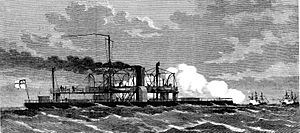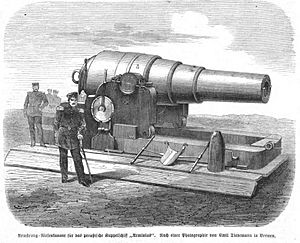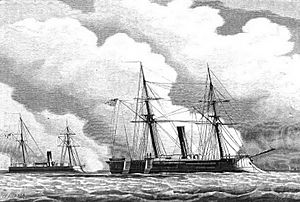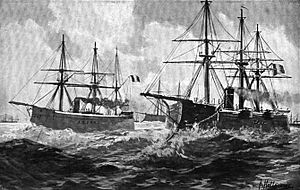SMS Arminius facts for kids

Illustration of SMS Arminius engaging French warships during the Franco-Prussian War
|
|
Quick facts for kids Class overview |
|
|---|---|
| Operators: |
|
| Preceded by: | None |
| Succeeded by: | Prinz Adalbert |
| History | |
| Name | SMS Arminius |
| Namesake | Arminius |
| Builder | Samuda Brothers, Cubitt Town, London |
| Laid down | 1863 |
| Launched | 20 August 1864 |
| Commissioned | 22 April 1865 |
| Decommissioned | 1875 |
| Stricken | 2 March 1901 |
| Fate | Scrapped, 1902 |
| General characteristics | |
| Type | Turret ship |
| Displacement | Full load: 1,829 t (1,800 long tons) |
| Length | 63.21 m (207 ft 5 in) |
| Beam | 10.9 m (35 ft 9 in) |
| Draft | 7.6 m (24 ft 11 in) |
| Installed power | |
| Propulsion | |
| Sail plan | Schooner-rigged |
| Speed | 10 knots (19 km/h; 12 mph) |
| Range | 2,000 nmi (3,700 km; 2,300 mi) at 8 kn (15 km/h; 9.2 mph) |
| Crew |
|
| Armament | 4 × 21 cm (8.3 in) Krupp guns |
| Armor |
|
SMS Arminius was a special kind of warship called an ironclad warship. She belonged to the Prussian Navy, which later became the Imperial German Navy. This ship was a turret ship, meaning her main guns were in spinning towers. A British naval officer named Captain Cowper Coles designed her. The Samuda Brothers shipyard in London built her.
Prussia bought the ship during the Second Schleswig War against Denmark. However, she arrived after the war ended. Arminius had four 21 cm (8.3 in) guns. These guns were placed in two turning gun turrets in the middle of the ship. She was named after Arminius, a famous German leader who won the Battle of the Teutoburg Forest.
For her first six years, Arminius protected the coast for the Prussian Navy. She was very active in the Austro-Prussian War and the Franco-Prussian War. These wars helped to unite Germany. During the war with France, she was the main ship trying to break the French blockade of German ports. After these wars, Arminius was used for other jobs. She became a training ship for engine crews and helped the school ship Blücher. The ship was sold in 1901 and taken apart for scrap metal in 1902.
Contents
Ship Design and Features
The warship SMS Arminius was designed by Captain Cowper Coles. He was a British naval officer who strongly believed in ironclad warships with gun turrets. Arminius was almost the same as the Danish ironclad Rolf Krake, which Coles also designed.
Size and Engines
Arminius was 63.21 m (207 ft 5 in) long overall. Her beam (width) was 10.9 m (35 ft 9 in). Her draft (how deep she sat in the water) was about 4.32 m (14 ft 2 in). She was built to weigh about 1,653 metric tons (1,627 long tons). But when fully loaded, Arminius weighed up to 1,829 t (1,800 long tons). Her body was made of iron and had eight watertight compartments. Like many warships back then, she had a strong ram bow at the front.
The ship's crew included ten officers and 122 sailors. She also carried smaller boats, like two pinnaces and two cutters. Arminius had some design problems. She rolled a lot, especially in rough seas. Water often came over her bow. She also steered unevenly, turning quickly to the right but slowly to the left. To go straight, her rudder had to be turned 15 degrees to the left. It was also impossible to control the ship using only her sails.
The ship used one two-cylinder single-expansion steam engine. This engine was built by J. Penn & Sons in Greenwich. It powered a single two-bladed screw propeller that was 3.96 m (13 ft) wide. Four coal-fired boilers made steam for the engine. These boilers were also built by J Penn & Sons. The ship could also use sails, with a schooner rig covering 540 square meters. The engine could produce 1,200 metric horsepower (1,200 ihp) of power. This gave her a top speed of 10 knots (19 km/h; 12 mph). On tests, Arminius actually reached 11.2 kn (20.7 km/h; 12.9 mph). She carried 171 t (168 long tons; 188 short tons) of coal. This allowed her to travel 2,000 nautical miles (3,700 km; 2,300 mi) at a speed of 8 kn (15 km/h; 9.2 mph).
Guns and Protection
When first built, Arminius had four bronze 72-pounder cannons. After Prussia bought her, these were replaced. She received four Krupp 21 cm RK L/19 guns, which were 20.95 cm (8.25 in) in size. The ship carried 332 rounds of ammunition for these guns. They could be raised to shoot up to 12 degrees. At this angle, they could hit targets 2,800 m (3,100 yd) away. After 1881, four machine guns were added. A single 35 cm (13.8 in) torpedo tube was also installed in the front of the ship, above the water.
Arminius's armor was made of wrought iron with teak wood behind it. The conning tower (where the ship was steered from) had 114 mm (4.5 in) of wrought iron. This was backed by 229 mm (9 in) of teak. The armored belt around the ship's waterline varied in thickness. It was 76 mm (3 in) thick at the front and back. In the middle, it was 114 mm thick. This entire belt was backed by 229 mm of teak. The two gun turrets had 114 mm of iron armor. This was backed by 406 mm (16 in) of wood.
Ship's History
Building the Ship
The ship was built by the Samuda Brothers shipyard in London. They built it hoping to sell it, maybe even to the Confederate Navy. Her construction started in 1863. She was launched into the water on August 20, 1864. Prussia bought the ship on the same day for about 1,887,000 gold marks. Some of this money came from public donations.
Prussia wanted the ship by September. But the British government delayed delivery because of the Second Schleswig War between Prussia and Denmark. Britain supported Denmark. So, they stopped the ship from being delivered until the war was over.
When launched, she was named Arminius. This was after Arminius, a German hero who defeated the Romans in 9 CE. This name was chosen to show the strong feeling of German unity at that time. The ship's official start of service was delayed. The Prussian navy decided to use the sailors meant for Arminius on another ship, the new Template:Screw corvette Victoria. Also, heavy ice in the Kieler Förde kept Arminius from entering port until April 4, 1865. Victoria arrived in London on April 20 with a second crew. This allowed Arminius to start service two days later.
After starting service, the ship did initial sea trials (tests at sea). Her guns were not yet installed. On May 3, she and Victoria left Britain. They sailed across the North Sea. After facing bad storms, they stopped in Skagen, Denmark, for shelter. They then stopped in Helsingør, Denmark. They finally arrived in Kiel on May 15. On June 1, she sailed to Danzig. There, she was taken out of service to have her guns put in. Arminius was one of the first armored warships bought by the Prussian Navy. The other was the ironclad ram Prinz Adalbert.
Austro-Prussian War
Arminius was put back into service in May 1866. Her commander was Korvettenkapitän (Corvette Captain) Reinhold von Werner. Work was planned on her gun turrets, but it was delayed. Tensions between Austria and Prussia were growing. Arminius received her mobilization order on May 12. She was told to go to Kiel, which was controlled by Austria at the time. The Prussians hoped her presence would scare the Austrian commander. She arrived there on June 1. Five days later, she anchored near the city's defenses.
The next day, Arminius joined a squadron led by Konteradmiral (Rear Admiral) Eduard von Jachmann. His main ship was the Template:Screw frigate Arcona. Arminius joined other ships moving from the Baltic Sea to Jachmann's squadron in the North Sea. These included the aviso Loreley and the gunboats Tiger, Cyclop, and Wolf. Werner took command of this group and was called Kommodore (Commodore). The ships set sail on June 12. They passed through the Danish straits and into the North Sea.
The ships reached Hamburg. They had traveled about 940 nautical miles (1,740 km; 1,080 mi) in 100 hours. This was very good for an early ironclad warship. The war had not started yet. So, the ships were first ordered to watch Austrian troops in Holstein. The Prussians knew these troops would retreat to Hannoverian land if war started. Trouble broke out in Altona. Werner sent a small group of sailors ashore to secure the train station there. The Austro-Prussian War began on June 14. Fighting with Hannover started the next day. Austria was not a naval threat. So, the Prussian navy focused on the Kingdom of Hanover.
For the rest of the war, Arminius operated from Geestemünde. Werner was still in command. Just seeing Arminius made several Hannoverian coastal forts surrender. On June 15, Arminius, Tiger, and Cyclop helped General Edwin von Manteuffel and 13,500 soldiers cross the Elbe river to attack Hanover. The crossing took ten hours. Werner's ships later helped more troops, including cavalry and artillery, cross.
Arminius, Cyclop, and Tiger sent men ashore at Brunshausen. There, they disabled the guns of an empty coastal artillery fort. Werner then sent Tiger and Wolf to attack forts at the mouth of the Elbe. Cyclop went to attack the fort at Grauerort. Arminius entered the Elbe on June 17. But bad storms stopped her from catching a steamship carrying Hannover's gold to Britain. By June 22, the Prussian army, helped by Werner's ships, had captured all major forts guarding the Elbe, Weser, and Ems rivers. Other naval forces arrived to make the Prussian fleet stronger. Arminius and the other ships then patrolled the coast of Ostfriesland to show their presence. By the end of the month, the Prussian army had won a big victory at Königgrätz. This ended the war. After the peace treaty was signed, Werner's group of ships was broken up on August 23. Arminius returned to Kiel.
On October 3, the USS Miantonomoh, a monitor from the US Navy, arrived in Kiel. She was on a tour of European ports. The next day, she and Arminius raced. Arminius was two knots faster. Arminius was taken out of service on October 20. She was only used again in 1867 as a gunnery training ship. This was to help Thetis, which did not have turret guns. In June, work to update the ship began in Kiel. But in September, she had to go to Karlskrona, Sweden. There, she was put in a dry dock to clean her bottom. She returned to Germany in late November. She was taken out of service again for work to continue. This update included changing her original masts to lighter pole masts. A new weather deck was also added. This deck went from behind the front turret to the back of the ship. Ventilators for the hull were extended through this new deck. In 1870, her sailing masts were removed completely. It was found that she could not be steered with sails. Also, the masts blocked the firing range of her gun turrets. Work on the ship was delayed by accidents during sea tests. The ship was not ready for active duty again until just before the war with France.
Franco-Prussian War
When the Franco-Prussian War started on July 19, 1870, the Prussian Navy gathered its ships. Arminius and the armored frigates Kronprinz, Friedrich Carl, and König Wilhelm were sent to the North Sea naval base at Wilhelmshaven. Arminius received her order to prepare for war on the first day. At that time, she was in Kiel. On July 27, she sailed out under the command of KK Otto Livonius. She tried to break through the French blockade by staying close to the Swedish coast. Her shallow bottom allowed this. Sailing through Swedish waters also protected her from French attacks. The ship reached Cuxhaven on July 30. She then went to Wilhelmshaven on August 1.
The French navy was much stronger. But they had not planned well for attacking Prussian naval bases. They decided they could only attack with help from Denmark, which they did not get. Arminius and the three armored frigates, led by now Vizeadmiral (Vice Admiral) Jachmann, sailed out in early August 1870. They went to the Dogger Bank, but they did not find any French warships. The three frigates then had ongoing engine problems. This left Arminius alone to continue operations.
During the war, she sailed out from port over forty times. These trips did not lead to big battles. But she sometimes exchanged fire with the French warships blocking the port. She briefly fought a French frigate on August 24. But the French ship quickly left. For most of the war, Arminius stayed at the mouth of the Elbe river. The ironclad ram Prinz Adalbert and three small gunboats were with her. The three armored frigates stayed near the island of Wangerooge. Their crews tried to fix their troublesome engines there.
On September 11, the three frigates were ready for action again. They joined Arminius for another big operation. But again, they did not meet any French ships. By this time, the French Navy had returned to France. On October 18, Arminius crashed into the aviso Falke. Arminius was not badly damaged. But Falke had a large hole below the waterline. On December 23, Arminius and the other ships in Wilhelmshaven entered the inner harbor. The harbor had recently been made deeper. The outer Jade Bay had frozen over, stopping any more operations for the winter.
Later Years
After the war, the German Kaiserliche Marine (Imperial Navy) began to reduce its forces in early 1871. On March 29, 1871, Arminius, the Template:Screw frigate Elisabeth, and the aviso Grille left Wilhelmshaven for the Baltic Sea. Bad storms delayed them. They reached Kiel on April 4. Arminius was taken out of service there on April 27.
Starting on May 1, 1872, the ship was used for training. She trained naval engineers and boiler room staff. KK Philipp von Kall was her commander. She also took part in shooting practice with the gunnery school. She was then taken out of service again on October 1. She continued her school ship duties from April 16 to May 31, 1873. Then from March 17 to mid-May 1874. And finally from March 15 to May 31, 1875. This was her last time in active service. After that, the ship was taken out of service and kept in reserve.
Her ram bow allowed her to be used as an icebreaker in the Baltic Sea in the 1880s. She was used for this in May 1881. She helped clear paths for ships in Kiel. In 1882, she was greatly updated. Then she was used to help the cadet training ship Blücher from August to November. In 1886 and again from January to July 1887, Arminius went back to her old training ship duties. Arminius was sent to the Flensburger Förde to break ice from March to April 1888.
The ship was rebuilt again later that year. During this refit, her engine system was updated and replaced with German-made parts. Two searchlights were also installed. Four machine guns were added, along with a 35 cm (13.8 in) torpedo tube. On October 10, she was reclassified as a special purpose vessel. However, she did not return to active service. She was officially removed from the naval register on March 2, 1901. Later that year, she was used in a weapons test. A new torpedo warhead was tested on her, causing a lot of damage. She was then sold to ship breakers for 72,000 gold marks in 1902. She was towed to Hamburg to be taken apart that year.




